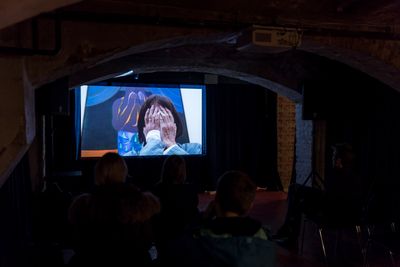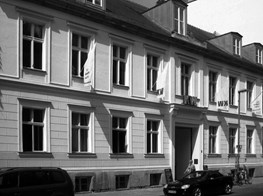Beatriz González at KW Institute for Contemporary Art: In Focus

Exhibition view: Beatriz González, Retrospective 1965–2017, KW Institute for Contemporary Art, Berlin (13 Oct 2018–6 Jan 2019). Courtesy KW Institute for Contemporary Art. Photo: Frank Sperling.
Retrospective 1965–2017, Beatriz González's exhibition at KW Institute for Contemporary Art in Berlin (13 October 2018–6 January 2019), presents a selection of 120 works that bear witness to Colombia's political and social upheavals of the last 50 years. Throughout, the link between González's practice and the sociopolitical context it references is made explicit with the inclusion of newspaper clippings displayed in vitrines shown alongside the drawings, prints, and paintings they inspired. Indeed, while the exhibition does honour the way González's work is often read within the global context of Pop Art, with brightly coloured paintings of British royals and Jackie Kennedy Onassis shown alongside entertainment news clippings, it mainly presents González within a tradition of political art.
Los Suicidas del Sisga No 2 (1965) is the first work one sees when entering the exhibition. At first glance, this oil on canvas painting of two figures could be understood as a happy couple dressed in their Sunday best. On closer inspection, their facial expressions seem plastered on, their features fading into washes of grey and ashy tones. Likewise, their fingers do not interlace but rather stick together, gum-like and inseparable. In a corner of the same room, a vitrine displays newspaper clippings of various tragic events, including a double suicide in which a woman and her partner drowned themselves, their portraits serving as the inspiration for the 'Los Suicidas del Sisga' series.
Los Suicidas del Sisga No 2 is an early example that demonstrates the artist's process of incorporating newspaper imagery into her artworks to reflect on society at large: in this case, how a news story could dismiss the deep emotion that drives such tragic acts. In the exhibition catalogue, Gónzalez explains to María Inés Rodríguez that she first saw the picture in a low-quality reprint—'small . . . badly printed [with] the features of the two figures . . . flattened'. This inspired the flat silhouettes that became characteristic of her style. ('I wanted to make underdeveloped paintings for underdeveloped countries', she once said.) The colour palette she employed in the work would also become distinctive: a link to the colours of the artist's hometown of Bucaramanga: specifically, the orange, green and purple cupola of a church there.
Gónzalez studied at the Universidad de los Andes in Bogotá under Spanish artist Juan Antonio Roda and Argentine art historian and critic Marta Traba: two figures credited for encouraging her interest in European Masters and new forms of Latin American contemporary art. In the KW's large exhibition hall, this influence is expressed by Telón de la móvil y cambiante naturaleza (1978): a large acrylic on canvas diptych that re-appropriates Édouard Manet's well-known painting Le Déjeuner sur l'herbe (1862/1863) as a minimalist composition of colour and shape. The painting is shown among a selection from the artist's furniture works, including La última mesa (1970), a rendition of Da Vinci's The Last Supper painted on a table, and Saluti da San Pietro. Trisagio (1971), three nightstands displaying the portraits of popes on them.
Overlooking this hall is Antonia Santos, sesquicentenario S.A. (1969), a circular enamel portrait on metal sheet depicting the Neogranadine rebel leader María Antonia Santos, who fought against invading Spanish troops in the early 19th century during the reconquest of New Granada. The painting is based on a portrait of Santos featured in the 30 June 1969 issue of the Colombian newspaper El Tiempo, in a story that describes Santos as a forgotten heroine; it gestures towards the increasingly political slant that Gónzalez expressed in her work as the years progressed.
In Diego García Moreno's documentary Beatriz González ¿Por qué llora si ya reí? (2010), on view in the KW Institute's basement bar, González talks about how her work became more openly critical of the government in the 1980s. At the time, she decided to use her role as an artist to bear witness to the violence occurring around her with 'rabia y fuerza' (rage and strength). This information contextualises pieces like Decoración de Interiores (1981): a massive silkscreen on fabric depicting then-president of Colombia, Julio César Turbay Ayala, drinking with dignitaries and socialites at a party. A response to the president's 1978 Security Statute, which gave sweeping powers to the state's security apparatus, and the tempering of public opinion towards these draconian measures by news outlets printing affable images of Ayala with his friends, González magnified one such image and repeated it three times on fabric. Installed like a curtain, the gesture points to the way images of gaiety were used to tapar—which means 'to cover', but colloquially indicates the covering up of a scandal—the unprecedented freedoms Ayala awarded the military to question and detain suspected militants without due process.
In her later work, González combined elements drawn from various newspaper images to create oil on canvas montages, thus departing from the focus on single images in the compositions of her earlier paintings exhibited in the first two rooms of the exhibition. In Contrapaeces (1996), a photograph of a woman with her hand on her forehead, seemingly in grief (identified as María del Carmen Camacho in a 1992 clipping from El Tiempo), is multiplied and flattened into yellow and blue silhouettes that line the top of the frame. Below, an arm emerges from one side and reaches for a bright, blue hand connected to half a torso: a reference to an image accompanying a 10 June 1994 El Tiempo news item about an earthquake in the municipality of Belalcázar, which triggered a mudslide killing some 1,000 people.
A clipping of this 1994 article is included in a vitrine in the adjacent room. It also references the 1985 eruption of the Nevado del Ruiz volcano, which caused a mudslide that killed 25,000 people in the town of Armero—a point of connection that hints at this painting's critique of the state's ineffectiveness in handling disasters of this scale. (The state could have prevented the 1985 tragedy had officials heeded warnings two months prior to evacuate the area.) The 1985 eruption also occurred one week after the M-19 guerrilla group besieged the Palace of Justice—a response to then-president Belisario Betancur's violation of a 1984 peace agreement between the government and the M-19 rebels. Betancur sent the military to quell the unrest, resulting in the deaths of nearly 100 hostages—an event that González says turned her art into 'something darker'.
Throughout this exhibition, the newspaper becomes a site of contention between state propaganda and real experience: source material that González uses to question sanctioned narratives and the reality that lurks behind them, so as to do justice to those affected by social and state violence. In this regard, it is helpful to view González's work within the larger context of Latin American contemporary art at the time. Take, for example, Chilean artist Catalina Parra, who also used the newspaper as a means to criticise the state; her assemblage Diario de Vida (1977) consists of pages of El Mercurio, a right-wing newspaper supportive of the Pinochet dictatorship, sewn together and pressed between two acrylic sheets joined by metal wing nuts. By appropriating a government-affiliated paper in this way, Parra avoided censorship, once proclaiming: 'How can you censor a cut or a tear?'
Likewise, by recontextualising images into minimalist forms, González reflects on experiences of real trauma without offering explicit—and sensationalising—representations, thus bypassing the language of propaganda altogether. Bearing witness to the human suffering caused by state violence and corruption rather than capitalising on it, this retrospective offers an excellent lesson to both curators and artists working with political art today.—[O]














































































































































































